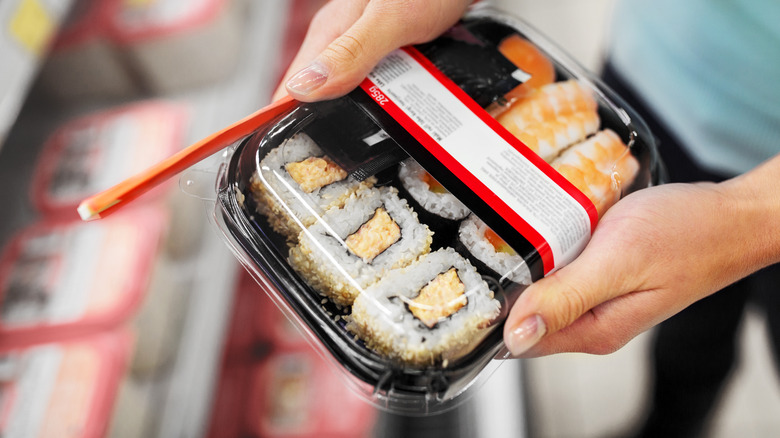Sushi is a popular Japanese dish that is enjoyed all over the world. However, sushi is also a delicate food that requires proper storage to maintain its freshness and flavor. In this article, we will discuss the best ways to store sushi to ensure it stays delicious and safe to eat.
1. Keep it Refrigerated

Sushi is best stored in the refrigerator to keep it fresh. If you have leftover sushi, wrap it tightly in plastic wrap or put it in an airtight container before placing it in the fridge. Make sure to consume the sushi within 24 hours of refrigeration to avoid any potential foodborne illnesses.
2. Don’t Freeze Sushi
While refrigeration is essential for storing sushi, freezing it is not recommended. Freezing sushi can alter the texture and flavor of the fish, making it less enjoyable to eat. Additionally, freezing sushi can also increase the risk of foodborne illnesses.
3. Use a Sushi Container

If you frequently enjoy sushi, consider investing in a sushi container. These containers are specially designed to store sushi and keep it fresh. They usually come with dividers to separate different types of sushi and prevent them from touching, which can cause the flavors to mix.
4. Avoid Direct Sunlight

Sunlight can cause sushi to spoil quickly, so it’s best to avoid direct sunlight when storing it. Keep your sushi in a cool, dark place like the refrigerator to maintain its freshness and flavor.
5. Keep Wasabi and Soy Sauce Separate

When storing sushi, it’s important to keep the wasabi and soy sauce separate. Wasabi can quickly lose its flavor when exposed to air, so it’s best to only add it to your sushi right before eating. Similarly, soy sauce should be added to your sushi right before eating to avoid making the rice soggy.
6. Use Fresh Ingredients
The freshness of your sushi depends on the quality of the ingredients you use. Make sure to use fresh fish and vegetables when making your sushi. Additionally, always check the expiration dates of any pre-packaged ingredients you use.
7. Don’t Overstuff the Sushi

When making sushi, it’s important not to overstuff it. Overstuffed sushi can be difficult to eat and can also cause the rice to fall apart. Additionally, overstuffing can cause the sushi to spoil more quickly.
8. Use Plastic Wrap

When storing sushi, use plastic wrap to keep it fresh. Wrap the sushi tightly so that it’s airtight and store it in the refrigerator. This will help prevent any odors from the fridge from affecting the sushi’s flavor.
9. Don’t Store Sushi for Too Long

While sushi can be refrigerated for up to 24 hours, it’s best to consume it as soon as possible. The longer you store sushi, the more likely it is to spoil and lose its flavor.
10. Keep Sushi Covered
When storing sushi in the refrigerator, make sure to keep it covered. This will help prevent any odors from the fridge from affecting the sushi’s flavor. Additionally, covering the sushi will help prevent it from drying out.
11. Use a Damp Cloth

If you need to store sushi outside of the refrigerator, use a damp cloth to keep it moist. Wrap the sushi tightly in the damp cloth and store it in a cool, dark place. Make sure to consume the sushi within a few hours of storage.
12. Use a Sushi Mat

When making sushi, use a sushi mat to help keep the rice and ingredients together. A sushi mat will also help prevent the rice from sticking to your hands, making it easier to make sushi.
13. Use Vinegar and Salt

When making sushi rice, add vinegar and salt to help preserve the rice and prevent it from spoiling. The vinegar and salt will also add flavor to the rice, making it more enjoyable to eat.
14. Keep Sushi Away from Other Foods

When storing sushi in the refrigerator, make sure to keep it away from other foods. This will help prevent any potential cross-contamination and keep the sushi fresh.
15. Use Freshly Cooked Rice

When making sushi, use freshly cooked rice to ensure it stays fresh. Older rice can cause the sushi to spoil more quickly and lose its flavor.
16. Use Freshly Grated Wasabi

If you enjoy wasabi with your sushi, use freshly grated wasabi to ensure it’s full of flavor. Pre-packaged wasabi can quickly lose its flavor and freshness, making it less enjoyable to eat.
17. Use a Sharp Knife

When cutting sushi, use a sharp knife to prevent the rice and ingredients from falling apart. A sharp knife will also make it easier to cut through the fish and vegetables.
18. Use High-Quality Fish

The quality of the fish you use in your sushi is essential for maintaining its freshness and flavor. Make sure to purchase high-quality fish from a reputable source to ensure it’s safe to eat.
19. Use a Sushi Press

If you frequently make sushi at home, consider investing in a sushi press. A sushi press will help you create perfectly shaped sushi and make it easier to store and transport.
20. Don’t Store Sushi at Room Temperature

Sushi should never be stored at room temperature. The warm environment can cause bacteria to grow quickly, increasing the risk of foodborne illnesses. Always store your sushi in the refrigerator to keep it fresh and safe to eat.
Related video of How to Store Sushi
Bananas are one of the most popular fruits in the world. They are delicious, nutritious, and versatile. You can eat them as they are, add them to smoothies, or use them in baking. However, bananas can also be quite finicky to store. They ripen quickly and can turn brown and mushy if not stored properly. Fortunately, there is a simple solution to this problem: storing bananas in the fridge. In this article, we will show you how to store bananas in the fridge to keep them fresh and tasty for longer.
Why Store Bananas In The Fridge?

Before we get into the specifics of how to store bananas in the fridge, let's talk about why you would want to do this in the first place. As mentioned earlier, bananas ripen quickly at room temperature. This is due to the release of ethylene gas, which speeds up the ripening process. When you store bananas in the fridge, the cold temperature slows down the production of ethylene gas, which helps to keep the bananas fresh for longer.
When To Store Bananas In The Fridge?

Now that you know why you should store bananas in the fridge, you may be wondering when to do so. The best time to put your bananas in the fridge is when they are ripe. Ripe bananas have a yellow skin with brown spots and are soft to the touch. If you put unripe bananas in the fridge, they will not ripen properly and may even turn black.
How To Store Bananas In The Fridge?

Storing bananas in the fridge is easy. Here's what you need to do:
- Choose ripe bananas with no visible bruises or damage.
- Peel the bananas and wrap them tightly in plastic wrap or aluminum foil.
- Place the wrapped bananas in a plastic bag.
- Put the bag in the fridge.
It's important to wrap the bananas tightly to prevent them from absorbing any odors in the fridge. You can store bananas in the fridge for up to two weeks, depending on how ripe they were when you put them in.
What To Do With Overripe Bananas?
If you have bananas that are already overripe and too soft to eat, don't throw them away. Overripe bananas are actually perfect for baking. You can use them to make banana bread, muffins, pancakes, and more. Simply mash the bananas and use them in your favorite recipe. You can also freeze overripe bananas and use them later.
Conclusion
Storing bananas in the fridge is a simple and effective way to keep them fresh for longer. By following the steps outlined in this article, you can ensure that your bananas stay delicious and nutritious for up to two weeks. And if you have any overripe bananas, don't throw them away. Use them in your favorite baking recipe and enjoy a tasty treat.
Related video of How To Store Bananas In Fridge

Hair growth is a natural process, but for some people, it can be frustrating to see hair grow back so quickly. Whether you have just shaved your head or have undergone a hair removal treatment, there are ways to slow down hair growth and enjoy smoother skin for longer.
Use Hair Inhibitors

Hair inhibitors are products that can help slow down hair growth by targeting the hair follicle. These products work by blocking the enzymes that are responsible for hair growth, making it difficult for hair to grow back quickly. Some popular hair inhibitors include creams, lotions, and sprays.
Try Natural Remedies

There are also natural remedies that can help slow down hair growth. For example, applying a paste made of turmeric and milk can help inhibit hair growth. Similarly, applying a mixture of sugar, lemon, and honey can also help slow down hair growth.
Consider Laser Hair Removal
Laser hair removal is a popular treatment that can help reduce hair growth permanently. This treatment works by targeting the hair follicle with a laser, damaging it and preventing hair from growing back. While laser hair removal can be expensive, it can provide long-lasting results.
Use Hair Growth Inhibiting Shampoos

Hair growth inhibiting shampoos are another option to consider. These shampoos contain ingredients that help slow down hair growth, such as saw palmetto and green tea extract. While these shampoos may not provide permanent results, they can help reduce hair growth for a few weeks.
Exfoliate Regularly

Exfoliating regularly can also help slow down hair growth. By removing dead skin cells, you can prevent hair from growing back as quickly. Use a gentle exfoliating scrub once or twice a week to keep your skin smooth and hair-free.
Avoid Shaving Too Often

Shaving too often can actually stimulate hair growth, making it grow back more quickly. Avoid shaving every day and instead wait for a few days before shaving again. This will give your skin time to recover and prevent hair from growing back too quickly.
Consider Waxing

Waxing is another popular hair removal method that can help slow down hair growth. When you wax, you remove the hair from the root, which can help prevent it from growing back as quickly. While waxing can be painful, it can provide longer-lasting results compared to shaving.
Watch Your Diet

Believe it or not, your diet can also play a role in hair growth. Eating foods that are high in protein, such as eggs and nuts, can help slow down hair growth. On the other hand, consuming foods that are high in sugar and carbohydrates can stimulate hair growth, making it grow back more quickly.
Consider Prescription Medications

If you have tried all of the above methods and are still struggling with fast hair growth, you may want to consider prescription medications. Medications such as spironolactone and finasteride can help reduce hair growth by blocking androgen hormones that stimulate hair growth.
Conclusion
There are many ways to slow down hair growth and enjoy smoother skin for longer. From using hair inhibitors to exfoliating regularly, there are options for everyone. Experiment with different methods and find the one that works best for you.
Related video of How To Stop Hair From Growing Back So Fast
Summer is a great time for outdoor activities, but unfortunately, it’s also the time when bugs are out in full force. Bug bites can be annoying and uncomfortable, but they don't have to ruin your fun. In this article, we’ll show you how to stop bug bites from itching and swelling, so you can enjoy the great outdoors without any discomfort.
Understanding Bug Bites

Before we dive into remedies, let's first understand what happens when a bug bites you. When a bug bites, it injects saliva into your skin to prevent your blood from clotting. This saliva contains proteins that your body may recognize as foreign, causing your immune system to release histamine as a response, leading to itching and swelling.
Immediate Remedies

If you get bitten by a bug, you'll likely experience itching and swelling. Fortunately, there are several immediate remedies you can use to alleviate these symptoms. Here are a few:
- Apply a cold compress to the bitten area for 10-15 minutes at a time
- Apply a paste made of baking soda and water to the bite
- Apply an over-the-counter hydrocortisone cream to the bite
- Take an antihistamine to reduce itching and swelling
Preventative Measures

The best way to prevent bug bites from itching and swelling is to avoid them in the first place. Here are some preventative measures you can take:
- Wear long-sleeved shirts and pants to cover your skin
- Use insect repellent on exposed skin and clothing
- Avoid wearing scented products, such as perfume or hair spray, as they can attract bugs
- Avoid being outside during peak bug hours, such as dawn and dusk
Natural Remedies

If you prefer natural remedies, there are several options you can try:
- Apply a few drops of lavender essential oil to the bitten area
- Apply aloe vera gel to the bite to reduce itching and swelling
- Apply a slice of fresh onion to the bite to reduce itching and swelling
- Apply a paste of crushed basil leaves to the bite
When To See A Doctor

Most bug bites are harmless and will go away on their own. However, there are times when you should seek medical attention. If you experience any of the following symptoms, see a doctor:
- Fever or chills
- Swollen lymph nodes
- Difficulty breathing
- Dizziness or weakness
- Severe swelling or redness
Conclusion
Bug bites are a common annoyance during the summer months, but there are many ways to stop them from itching and swelling. From immediate remedies to preventative measures and natural remedies, there are plenty of options to choose from. Remember to always seek medical attention if you experience severe symptoms, and don't let bug bites ruin your outdoor fun!
Related video of How To Stop Bug Bites From Itching And Swelling

Sticking out your tongue is a simple and fun gesture that can express a variety of emotions, from playful to silly. Whether you're doing it to make someone laugh or to show your disapproval, there are a few techniques you can use to make your tongue stick out even farther. In this article, we'll show you how to stick out your tongue like a pro.
1. Relax Your Mouth Muscles

The first step to sticking out your tongue is to relax your mouth muscles. This will make it easier for your tongue to move and extend farther out of your mouth. Start by taking a deep breath and exhaling slowly. As you exhale, let your jaw and lips go slack, and try to feel the tension in your mouth begin to release.
2. Push Your Tongue Forward

Once your mouth is relaxed, push your tongue forward against the roof of your mouth. This will help to engage the muscles in the back of your tongue, which will make it easier to extend your tongue farther out of your mouth. Push your tongue forward slowly and steadily, as far as it will comfortably go.
3. Curl the Edges of Your Tongue

If you want to stick out your tongue even farther, try curling the edges of your tongue upward. This will create a more pronounced curve in your tongue and make it look longer. To do this, press the sides of your tongue up against your top molars, and then curl the edges of your tongue upward while keeping the center of your tongue flat.
4. Open Your Mouth Wide
If you're having trouble getting your tongue to stick out far enough, try opening your mouth wider. This will give your tongue more room to move and help you extend it farther out of your mouth. Keep your lips relaxed and open your mouth as wide as you comfortably can.
5. Practice Makes Perfect

Like any skill, sticking out your tongue takes practice. Don't be discouraged if you can't get it right the first time – keep practicing and you'll get better over time. Try sticking out your tongue in front of a mirror and experimenting with different techniques until you find what works best for you.
6. Use Your Tongue to Make Funny Faces

Sticking out your tongue is a great way to make funny faces and express your playful side. Try using your tongue to make different shapes and movements, such as curling it into a tube or wagging it back and forth. The possibilities are endless!
7. Don't Stick Out Your Tongue Too Far

While it's fun to stick out your tongue, be careful not to overdo it. Sticking out your tongue too far can be uncomfortable and even harmful, as it can cause strain on your tongue and jaw muscles. Stick to a comfortable distance and take breaks if you start to feel any discomfort or pain.
8. Have Fun!
At the end of the day, sticking out your tongue is all about having fun and expressing yourself. Whether you're doing it to make someone laugh or just because it feels good, don't forget to have fun with it!
Related video of How To Stick Out Your Tongue Wikihow
Toast is a simple yet delicious breakfast staple that can be enjoyed in many ways. Whether you prefer it with butter and jam or topped with avocado and eggs, the possibilities are endless. But have you ever wondered how to start a toast? Follow these simple steps to create the perfect slice of toast.
Step 1: Choose Your Bread

The first step in starting a toast is choosing the right bread. There are many types of bread to choose from, including white, whole wheat, sourdough, and rye. Each type of bread has its unique flavor and texture, so pick the one that suits your taste buds.
Step 2: Preheat Your Toaster
Before you start toasting your bread, make sure your toaster is preheated. This will ensure that your toast cooks evenly and comes out perfectly crispy. Set your toaster to the desired level of doneness, depending on how you like your toast.
Step 3: Toast Your Bread

Once your toaster is preheated, it's time to toast your bread. Place your bread slices in the toaster and press down the lever. Wait for a few minutes until your toast is golden brown and crispy. If you want your toast to be darker, simply toast it for a little longer.
Step 4: Add Your Toppings
Now it's time to add your favorite toppings to your toast. Whether you prefer sweet or savory, there are countless options to choose from. Some popular toppings include butter, jam, honey, peanut butter, avocado, eggs, and bacon.
Step 5: Enjoy Your Toast

Finally, it's time to enjoy your delicious toast. Sit back, relax, and savor every bite of your perfectly toasted bread. Whether you're having it for breakfast, lunch, or a snack, toast is a simple pleasure that can brighten up your day.
Tips For Making The Perfect Toast

Here are some additional tips for making the perfect toast:
- Make sure your bread is fresh and not stale.
- Use a toaster that allows you to adjust the level of toasting.
- Don't overcrowd your toaster, as this can lead to uneven toasting.
- If you're making multiple slices of toast, wait for the toaster to cool down between batches.
- Experiment with different toppings to find your favorite combination.
Conclusion
Starting a toast is a simple and easy process that anyone can do. With the right bread, toaster, and toppings, you can create a delicious and satisfying breakfast or snack. Follow these steps and tips to make the perfect toast every time.